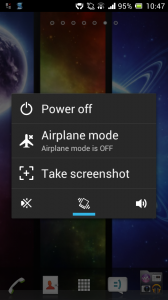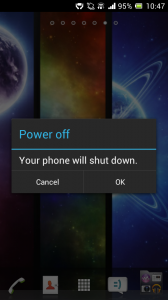In Depth : Android Shutdown Sequence
来源:互联网 发布:linux桌面环境比较 编辑:程序博客网 时间:2024/05/16 10:21
- What happened when I long press power button ?
- What is shutdown sequence ?
- How is it different from desktop linux shutdown sequence?
- How to change shutdown menu ?
Many questions pop-up in mind when we think about Android shutdown sequence. Before you read about shutdown sequence I suggest you to read about boot sequence article.
Android is linux based open source operating system, x86 (x86 is a series of computer microprocessor instruction set architectures based on the Intel 8086 CPU.) is most likely system where linux kernel is deployed however all Android devices are running on ARM process (ARM (formerly Advanced RISC Machine, which was formerly Acorn RISC Machine)) except Intel’s Xolo device (http://xolo.in/xolo-x900-features). Xolo comes with Atom 1.6 GHz x86 processor. Android shutdown sequence is different from desktop linux like ubuntu, fedora, etc.
In this article I am going to explain shutdown sequence for Android only. Please refer “Linux Boot and Shutdown Process” for details of desktop linux shutdown process.
Following diagram illustrate shutdown sequence in detail.

Step 1: Long Press Power Button for 500ms.
Step 2: PhoneWindowManager.java identify Power Button long press and call method named “interceptKeyBeforeQueueing”.
Following code display power key snippet from the function.
01/** {@inheritDoc} */02@Override03public int interceptKeyBeforeQueueing(KeyEvent event, int policyFlags, boolean isScreenOn) {04....05....06....07case KeyEvent.KEYCODE_POWER: {08 result &= ~ACTION_PASS_TO_USER;09 if (down) {10 if (isScreenOn && !mPowerKeyTriggered11 && (event.getFlags() & KeyEvent.FLAG_FALLBACK) == 0) {12 mPowerKeyTriggered = true;13 mPowerKeyTime = event.getDownTime();14 interceptScreenshotChord();15 }16 ITelephony telephonyService = getTelephonyService();17 boolean hungUp = false;18 if (telephonyService != null) {19 try {20 if (telephonyService.isRinging()) {21 // Pressing Power while there's a ringing incoming22 // call should silence the ringer.23 telephonyService.silenceRinger();24 } else if ((mIncallPowerBehavior25 & Settings.Secure.INCALL_POWER_BUTTON_BEHAVIOR_HANGUP) != 026 && telephonyService.isOffhook()) {27 // Otherwise, if "Power button ends call" is enabled,28 // the Power button will hang up any current active call.29 hungUp = telephonyService.endCall();30 }31 } catch (RemoteException ex) {32 Log.w(TAG, "ITelephony threw RemoteException", ex);33 }34 }35 interceptPowerKeyDown(!isScreenOn || hungUp36 || mVolumeDownKeyTriggered || mVolumeUpKeyTriggered);37 } else {38 mPowerKeyTriggered = false;39 cancelPendingScreenshotChordAction();40 if (interceptPowerKeyUp(canceled || mPendingPowerKeyUpCanceled)) {41 result = (result & ~ACTION_WAKE_UP) | ACTION_GO_TO_SLEEP;42 }43 mPendingPowerKeyUpCanceled = false;44 }45 break;46 }47....48....49....50}Above code handle multiple options like silence ringtone, take screenshots and power off. It will identify appropriate option based on time duration and other key’s status. It will call “interceptPowerKeyDown” option by eliminate other options.
Following code display interceptPowerKeyDown function. It will wait for 500 millisecond (ViewConfiguration#getGlobalActionKeyTimeout())
then call mPowerLongPress Thread.
1private void interceptPowerKeyDown(boolean handled) {2 mPowerKeyHandled = handled;3 if (!handled) {4 mHandler.postDelayed(mPowerLongPress, ViewConfiguration.getGlobalActionKeyTimeout());5 }6}Following code represent mPowerLongPress thread
01private final Runnable mPowerLongPress = new Runnable() {02 @Override03 public void run() {04 // The context isn't read05 if (mLongPressOnPowerBehavior < 0) {06 mLongPressOnPowerBehavior = mContext.getResources().getInteger(07 com.android.internal.R.integer.config_longPressOnPowerBehavior);08 }09 int resolvedBehavior = mLongPressOnPowerBehavior;10 if (FactoryTest.isLongPressOnPowerOffEnabled()) {11 resolvedBehavior = LONG_PRESS_POWER_SHUT_OFF_NO_CONFIRM;12 }13 14 switch (resolvedBehavior) {15 case LONG_PRESS_POWER_NOTHING:16 break;17 case LONG_PRESS_POWER_GLOBAL_ACTIONS:18 mPowerKeyHandled = true;19 if (!performHapticFeedbackLw(null, HapticFeedbackConstants.LONG_PRESS, false)) {20 performAuditoryFeedbackForAccessibilityIfNeed();21 }22 sendCloseSystemWindows(SYSTEM_DIALOG_REASON_GLOBAL_ACTIONS);23 showGlobalActionsDialog();24 break;25 case LONG_PRESS_POWER_SHUT_OFF:26 case LONG_PRESS_POWER_SHUT_OFF_NO_CONFIRM:27 mPowerKeyHandled = true;28 performHapticFeedbackLw(null, HapticFeedbackConstants.LONG_PRESS, false);29 sendCloseSystemWindows(SYSTEM_DIALOG_REASON_GLOBAL_ACTIONS);30 mWindowManagerFuncs.shutdown(resolvedBehavior == LONG_PRESS_POWER_SHUT_OFF);31 break;32 }33 }34 };Step 3: Controls goes to GlobalActions.java which is responsible to display dialogbox with various options like (Power Off, Airplan mode, Take screenshot and few toggle buttons), This dialog box has different options are per your OEM provider, model and Android OS version. GlobalAction class has method named showdialog() which is responsible to create object of Dialogbox with options.
01void showGlobalActionsDialog() {02 if (mGlobalActions == null) {03 mGlobalActions = new GlobalActions(mContext, mWindowManagerFuncs);04 }05 final boolean keyguardShowing = keyguardIsShowingTq();06 mGlobalActions.showDialog(keyguardShowing, isDeviceProvisioned());07 if (keyguardShowing) {08 // since it took two seconds of long press to bring this up,09 // poke the wake lock so they have some time to see the dialog.10 mKeyguardMediator.userActivity();11 }12}
Step 4: If user select “Power Off” option from the dialogbox then control again goes back to PhoneWindowManager, It will start shutdown process.
Step 5: Shutdown process initiate from ShutdownThread.java file’s shoutdowninner() function, It wil display confirmation dialog with ok / cancel button, If user select ok option then actual shutdown process starts.

Step 6: beginShutdownSequence() function called when user select OK option from the dialog.
01private static void beginShutdownSequence(Context context) {02 synchronized (sIsStartedGuard) {03 if (sIsStarted) {04 Log.d(TAG, "Shutdown sequence already running, returning.");05 return;06 }07 sIsStarted = true;08 }09 10 // throw up an indeterminate system dialog to indicate radio is11 // shutting down.12 ProgressDialog pd = new ProgressDialog(context);13 pd.setTitle(context.getText(com.android.internal.R.string.power_off));14 pd.setMessage(context.getText(com.android.internal.R.string.shutdown_progress));15 pd.setIndeterminate(true);16 pd.setCancelable(false);17 pd.getWindow().setType(WindowManager.LayoutParams.TYPE_KEYGUARD_DIALOG);18 19 pd.show();20 21 sInstance.mContext = context;22 sInstance.mPowerManager = (PowerManager)context.getSystemService(Context.POWER_SERVICE);23 24 // make sure we never fall asleep again25 sInstance.mCpuWakeLock = null;26 try {27 sInstance.mCpuWakeLock = sInstance.mPowerManager.newWakeLock(28 PowerManager.PARTIAL_WAKE_LOCK, TAG + "-cpu");29 sInstance.mCpuWakeLock.setReferenceCounted(false);30 sInstance.mCpuWakeLock.acquire();31 } catch (SecurityException e) {32 Log.w(TAG, "No permission to acquire wake lock", e);33 sInstance.mCpuWakeLock = null;34 }35 36 // also make sure the screen stays on for better user experience37 sInstance.mScreenWakeLock = null;38 if (sInstance.mPowerManager.isScreenOn()) {39 try {40 sInstance.mScreenWakeLock = sInstance.mPowerManager.newWakeLock(41 PowerManager.FULL_WAKE_LOCK, TAG + "-screen");42 sInstance.mScreenWakeLock.setReferenceCounted(false);43 sInstance.mScreenWakeLock.acquire();44 } catch (SecurityException e) {45 Log.w(TAG, "No permission to acquire wake lock", e);46 sInstance.mScreenWakeLock = null;47 }48 }49 50 // start the thread that initiates shutdown51 sInstance.mHandler = new Handler() {52 };53 sInstance.start();54 }Run method, start actual shutdown process
001public void run() {002 BroadcastReceiver br = new BroadcastReceiver() {003 @Override public void onReceive(Context context, Intent intent) {004 // We don't allow apps to cancel this, so ignore the result.005 actionDone();006 }007 };008 009 /*010 * Write a system property in case the system_server reboots before we011 * get to the actual hardware restart. If that happens, we'll retry at012 * the beginning of the SystemServer startup.013 */014 {015 String reason = (mReboot ? "1" : "0") + (mRebootReason != null ? mRebootReason : "");016 SystemProperties.set(SHUTDOWN_ACTION_PROPERTY, reason);017 }018 019 /*020 * If we are rebooting into safe mode, write a system property021 * indicating so.022 */023 if (mRebootSafeMode) {024 SystemProperties.set(REBOOT_SAFEMODE_PROPERTY, "1");025 }026 027 Log.i(TAG, "Sending shutdown broadcast...");028 029 // First send the high-level shut down broadcast.030 mActionDone = false;031 Intent intent = new Intent(Intent.ACTION_SHUTDOWN);032 intent.addFlags(Intent.FLAG_RECEIVER_FOREGROUND);033 mContext.sendOrderedBroadcastAsUser(intent,034 UserHandle.ALL, null, br, mHandler, 0, null, null);035 036 final long endTime = SystemClock.elapsedRealtime() + MAX_BROADCAST_TIME;037 synchronized (mActionDoneSync) {038 while (!mActionDone) {039 long delay = endTime - SystemClock.elapsedRealtime();040 if (delay <= 0) {041 Log.w(TAG, "Shutdown broadcast timed out");042 break;043 }044 try {045 mActionDoneSync.wait(delay);046 } catch (InterruptedException e) {047 }048 }049 }050 051 Log.i(TAG, "Shutting down activity manager...");052 053 final IActivityManager am =054 ActivityManagerNative.asInterface(ServiceManager.checkService("activity"));055 if (am != null) {056 try {057 am.shutdown(MAX_BROADCAST_TIME);058 } catch (RemoteException e) {059 }060 }061 062 // Shutdown radios.063 shutdownRadios(MAX_RADIO_WAIT_TIME);064 065 // Shutdown MountService to ensure media is in a safe state066 IMountShutdownObserver observer = new IMountShutdownObserver.Stub() {067 public void onShutDownComplete(int statusCode) throws RemoteException {068 Log.w(TAG, "Result code " + statusCode + " from MountService.shutdown");069 actionDone();070 }071 };072 073 Log.i(TAG, "Shutting down MountService");074 075 // Set initial variables and time out time.076 mActionDone = false;077 final long endShutTime = SystemClock.elapsedRealtime() + MAX_SHUTDOWN_WAIT_TIME;078 synchronized (mActionDoneSync) {079 try {080 final IMountService mount = IMountService.Stub.asInterface(081 ServiceManager.checkService("mount"));082 if (mount != null) {083 mount.shutdown(observer);084 } else {085 Log.w(TAG, "MountService unavailable for shutdown");086 }087 } catch (Exception e) {088 Log.e(TAG, "Exception during MountService shutdown", e);089 }090 while (!mActionDone) {091 long delay = endShutTime - SystemClock.elapsedRealtime();092 if (delay <= 0) {093 Log.w(TAG, "Shutdown wait timed out");094 break;095 }096 try {097 mActionDoneSync.wait(delay);098 } catch (InterruptedException e) {099 }100 }101 }102 103 rebootOrShutdown(mReboot, mRebootReason);104 }Step 7: With rebootOrShutdown() method controls transfer to the native function of com_android_server_power_PowerManagerService.cpp file, and finally control goes to android_reboot.c file which is final step of shutdown sequence.
1static void nativeShutdown(JNIEnv *env, jclass clazz) {2 android_reboot(ANDROID_RB_POWEROFF, 0, 0);3}- In Depth : Android Shutdown Sequence
- Sequence of shopping carts in-depth analysis with R(1)
- Sequence of shopping carts in-depth analysis with R(3)– Sequence of events
- Sequence of shopping carts in-depth analysis with R(2) – Clustering
- Network+ 2005 In Depth
- read 'Database In Depth'
- Containers in depth笔记
- Controller in depth
- [CSharp In Depth]迭代器
- Lightmapping In-Depth[Unity]
- C# in Depth
- C# in Depth
- 《Indy In Depth》中文版
- Startup- and Shutdown sequence of OpenOffice.org
- [SQL] Shutdown is in progress
- ORA-01090: shutdown in progress
- Android 4.2 Shutdown procedure
- Android Security Internals, An In-Depth Guide to Android's Security Architecture 笔记
- C# WinForm开发系列 - DataGrid/DataGridView(转)
- CSS控制文本超出指定宽度后用省略号代替
- 自动编译工具 Visual Build Professional
- web.xml里面添加注释的方法<!-- -->
- 空格验证
- In Depth : Android Shutdown Sequence
- C# WinForm开发系列 - Grid Controls(转)
- 使用 xmanager 4 远程连接 centos6.3
- Oracle 11.2.0.4.0 Patchset released
- 检查点基础
- Loadrunner 中html 模式与URL模式的区别
- 不可或缺的xmlhttp.setRequestHeader()
- USB android 层链接
- mysql-tpcc使用方法


